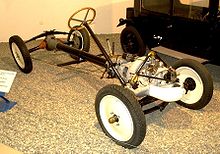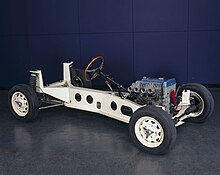Backbone chassis


Backbone tube chassis is a type of automobile construction chassis that is similar to the body-on-frame design. Instead of a two-dimensional ladder-type structure, it consists of a strong tubular backbone (usually rectangular in cross section) that connects the front and rear suspension attachment areas. A body is then placed on this structure.
Design
The backbone chassis is a design feature of Czech Tatra heavy trucks[1] (cross-country, military etc.). Hans Ledwinka developed this style of chassis for the Tatra 11 in 1923.[2] He further enhanced the design with 6x4 model Tatra 26, which had excellent offroad abilities.



This type of chassis is also often found on some sports cars. It does not provide protection against side collisions, and thus has to be combined with a body that would compensate for this shortcoming.
Examples of cars using a backbone chassis are De Tomaso Mangusta, DeLorean DMC-12, Lloyd 600, Lotus Elan, Lotus Esprit and Europa, Škoda 420 Popular, Tatra T-87, Tatra T111, Tatra T148, Tatra T815 etc., as well as TVR S1. Some cars also use a backbone as a part of the chassis to strengthen it; examples include the Volkswagen Beetle, where the transmission tunnel forms a backbone.
Hybrid backbone-ladder chassis
The Locost may appear to be using a backbone in addition to the outer space frame; however, examination shows that, in standard form, it is adding negligible stiffness and only serves as a convenient support structure for the sheet metal panels forming the transmission tunnel. The Triumph Herald and Triumph Vitesse used a twin flanged box section[3] backbone carrying the main torsional[citation needed] and bending loads, with light channel section side rails to stiffen the body, while the Triumph Spitfire and Triumph GT6 sports cars used only the twin-box section backbone, with separate side members in the body, and rear suspension fore and aft loads were also taken by the floor, not the backbone chassis directly.
Advantages
- A standard-conception truck's superstructure has to withstand the torsion twist, and subsequent wear reduces vehicle's lifespan.
- The half-axles have better contact with the ground when operated off-road. This has little importance on roads.
- The vulnerable parts of the drive shaft are covered by a thick tube. The whole system is extremely reliable. However, if a problem occurs, repairs are more complicated.
- The modular system enables configurations of 2-, 3-, 4-, 5-, 6-, or 8-axle vehicles with various wheel bases.[4][5]
Disadvantages
- Manufacturing the backbone chassis is more complicated and more costly. However, the more axles with all-wheel drive are needed, the cost benefit turns in favor of backbone chassis.
- The backbone chassis is heavier for a given torsional stiffness than a uni-body.
- The chassis gives no protection against side impacts.
See also
- Tatra concept
- Frame (vehicle)
- Body-on-frame
- Chassis
- Coachwork
- Monocoque
- Spaceframe
- Subframe
- Superleggera
- Swing axle
References
- ^ "Tatra AS". Archived from the original on 28 March 2010. Retrieved 22 August 2013.
- ^ "TATRA TAKES YOU FURTHER". Retrieved 1 July 2015.
- ^ http://www.paulstriumphherald.co.uk/wp-content/uploads/2016/08/10-1.jpg
- ^ "Build your own TATRA - Segment selection". Retrieved 1 July 2015.
- ^ "An all time longest and heaviest TATRA has been produced!". Tatra. 21 August 2015.
External links
- Comparison of standard ladder chassis and backbone chassis with half axles on offroad testing track with emphasis on the twist of superstructure (video):
- Ladder chassis (Renault fire engine)
- Backbone chassis (Tatra T815 fire engine)
